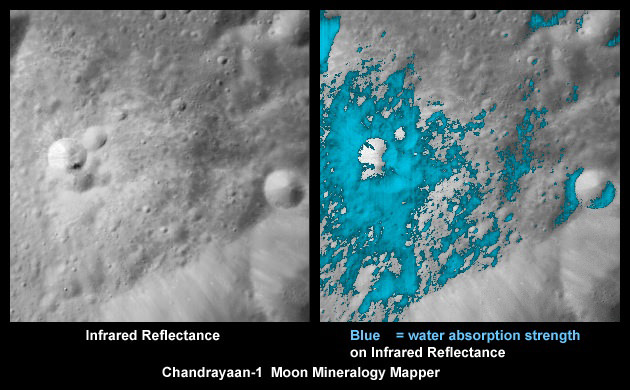When they first set foot on the Moon, the Apollo 11 astronauts painted a picture of the landscape as a bone-dry desert. So astronomers were naturally surprised when in 2009, three probes showed that a lot of water is locked up in minerals in the soil. There has been some debate as to where the water came from, but now two researchers with the National Museum of Natural History in Paris, France, have determined that most of the water in the soil on the surface of the Moon was formed due to protons in the solar wind colliding with oxygen in lunar dust, rather than from comet or meteorite impacts.
The first hints that there was water on the Moon came when India’s Chandrayaan-1 found hints of water across the lunar surface when it measured a dip in reflected sunlight at a wavelength absorbed only by water and hydroxyl, a molecule that contains one atom of hydrogen and one atom of oxygen.
To help clarify this picture, NASA scientists turned to data collected by two of their space probes – the Cassini probe, which buzzed the moon in 1999 on its way to Saturn, and NASA’s Deep Impact spacecraft, which flew past the moon in June 2009 en route to an encounter with the comet Hartley 2. Both spacecraft confirmed the evidence of water and hydroxyl, molecules that are likely both present on the moon.

There were three likely explanations as to how that water got there. Comets and meteorites were two possibilities, while others believed it may be caused by solar wind. In the latter case, the water would have been formed by streams of plasma emanating from the sun’s upper atmosphere and smashing high-energy protons into the moon’s surface. Cosmic rays from outside the solar system could inject ions into lunar rocks as well, causing chemical changes that create water.
To find out the likeliest source of the water, Alice Stephant and Francois Robert measured the ratio of hydrogen and deuterium in soil samples from the Apollo 16 and Apollo 17 missions. They ran the samples through a type of mass spectrometer that not only detects which isotopes are present but how deep down they are in a surface sample.
In studying tiny grains of lunar soil samples, they found that the reduction of oxygen from silicates in the soil by protons from the solar wind was almost certainly the means by which the water was generated. They came to that conclusion through determining the lithium isotope ratio in the samples which gave the isotope ratio for the hydrogen. From that, they were able to calculate the deuterium-hydrogen ratio which they compared to the amount of water actually in the granule sample.
Because there tends to be more deuterium further from the sun, each possible source of lunar water should give a different ratio. Comets and meteorites have distinctive proportions, while protons from the solar wind or cosmic rays would each have different ratios.
What they found was that on average, the granules contained just 15 percent water from somewhere else (presumably comets or meteorites) leaving the rest to have been formed due to the solar wind interaction. They note also that for some samples, all of the water was due to solar wind interaction.
“We confirm that result,” said Stephant. “Water-rich meteorite and comet impacts do not bring important amounts of water to the surface of the moon.”
Alberto Saal at Brown University in Providence, Rhode Island, is pleased with the result. “I think the idea that most of the water in the surface of the moon comes from solar wind implantations is most likely correct,” he says.
In their paper published in Proceedings of the National Academy of Sciences, Alice Stephant and François Robert describe their study and the results they found. However, they were also quick to point out that their conclusions only relate to water found on the surface of the moon – whereas the origin of the water below the surface is still open to interpretation.
Further reading: PNAS


This information is critical for understanding how chemosynthesis via solar wind particle interaction occurs in our solar system. This finding also goes a long way toward confirming that Saturn, on a vastly larger scale, also constantly manufactures water ice(s).
I would imagine that most of the water from comet impacts would have resulted in water resting on the service only to evaporate or be sublimated away (in the case of ice) over the history of the solar system after the late heavy bombardment.
Smashing high-energy protons into the moon’s surface resulting in embedded water molecules in the rocks sounds like something that would have a better chance of surviving the vacuum of space.
I’m no expert, just a wild guess.